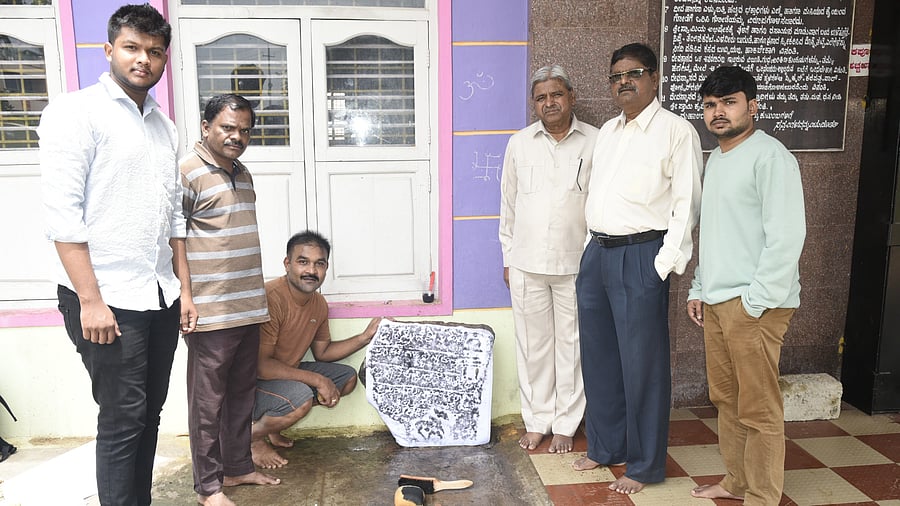
Prof N M Talwar, Project Director of the Center of Excellence for Studies in Classical Kannada, Senior researchers C A Shashidhara, R Mariswamy along with retired DCP Shivanna, P B Pramukh and Raghavendra with the inscription discovered at Naadanahalli in Mysuru.
Credit: DH Photo
Mysuru: A team of Center of Excellence for Studies in Classical Kannada of Mysuru have discovered an ancient inscription from the period of Ganga ruler Butuga II at the Mahalingeshwara temple at Naadanahalli in Mysuru.
The inscription on the right side wall of the temple, facing east, inscribed in white granite, measures two feet wide and two and a half feet tall, and contains six lines. Written in the Kannada language and script, this inscription is 1,076 years old, said C A Shashidhara C A Archaeological researcher of CESC, who led the team.
Shashidhara explained, "It is believed that during the reign of Butuga II, ruler of the Ganga kingdom, Butuga's bodyguard, Maremma of the Besta race, may have donated the garden without tax to the temple and entrusted its management to the village chief, Vijaketa Gavunda. The full text of the inscription cannot be accurately stated, as it is spoilt. However, since the inscription references 'Vijaketa Gavunda Dikku', it can be inferred that the management of the garden was entrusted to Vijaketa Gavunda, the Chief of the village. Additionally, the embossed painting of the temple is symbolically engraved on the inscription, confirming that it is a donation related to the temple. However, there is no information regarding which temple the donation inscription is associated with. Since the Shiva Linga in the Mahalingeshwara temple, where the inscription was found, is in the Ganga architectural style and the inscription is from the Ganga period, it can be understood that this donation inscription is related to the Mahalingeshwara temple. At the end of the inscription, an embossed sculpture of a cow feeding its calf has been carved, symbolizing that those who destroy or deface this inscription will incur the sin of killing a cow," he said.
This inscription, dated 948 AD, is inscribed in Kannada script and language and consists of six lines- "Śrīrājya vijaya samva; tsara sataṅgaḷeṇṭu nūḍē; ppatttu varṣa pravatti(ð)suttire permma; naḍiya mey gāpin mārēmmā toreyiga; pū tōṭṭa akarḷi taya vijakēttagā; muṇḍar.. dise".
Prof N M Talwar Project Director, CESC said, "The local people believed that the Mahalingeshwara temple was 200 to 300 years old. However, our research has revealed that this temple is about thousand years old. The Ganga kings built temples based on the population density of the area. When we observe the style of construction of this temple, we can comprehend the population that existed here thousands of years ago. The current researched inscriptions and temples shed light on the Ganga empire, and this research is a significant endeavor of our center."
C A Shashidhara also informed, "from 350 AD to 1004 AD, for around 650 long years, the rulers of the Ganga dynasty, who ruled over Karnataka, contributed significantly to the fields of architecture and literature by commissioning the construction of many temples and inscriptions. Since the Ganga temples are very ancient, some have been destroyed over time due to the ravages of history. Others have been completely renovated in the name of restoration, losing their original Ganga architectural style. Due to a lack of awareness among the locals, many such temples are mistakenly believed to have been constructed during the Chola period or under other dynasties. However, based on the inscription and the Shiva Linga found in the present Mahalingeshwara temple, it is evident that this temple was originally built during the Ganga period and is a thousand years old. This research has played a crucial role in preserving the legacy of the Ganga dynasty, ensuring their contributions are not attributed to others."
Based on the information provided by retired DCP Shivanna to archaeologist Prof N S Rangaraju, Archaeological researcher C A Shashidhara conducted fieldwork and discovered this ancient inscription. With the approval of Prof Shailendra Mohan, director of the Central Institute of Indian Languages, and under the leadership of Prof N M Talwar, PD of CESC, a team was formed. Team comprising archaeological researcher C A Shashidhara, Junior researcher R Mariswamy, and photographer Ramesh Patel, took an estampage of the inscription along with the co-operation of local resident, retired DCP Shivanna, along with P M Pramukh and Raghavendra.